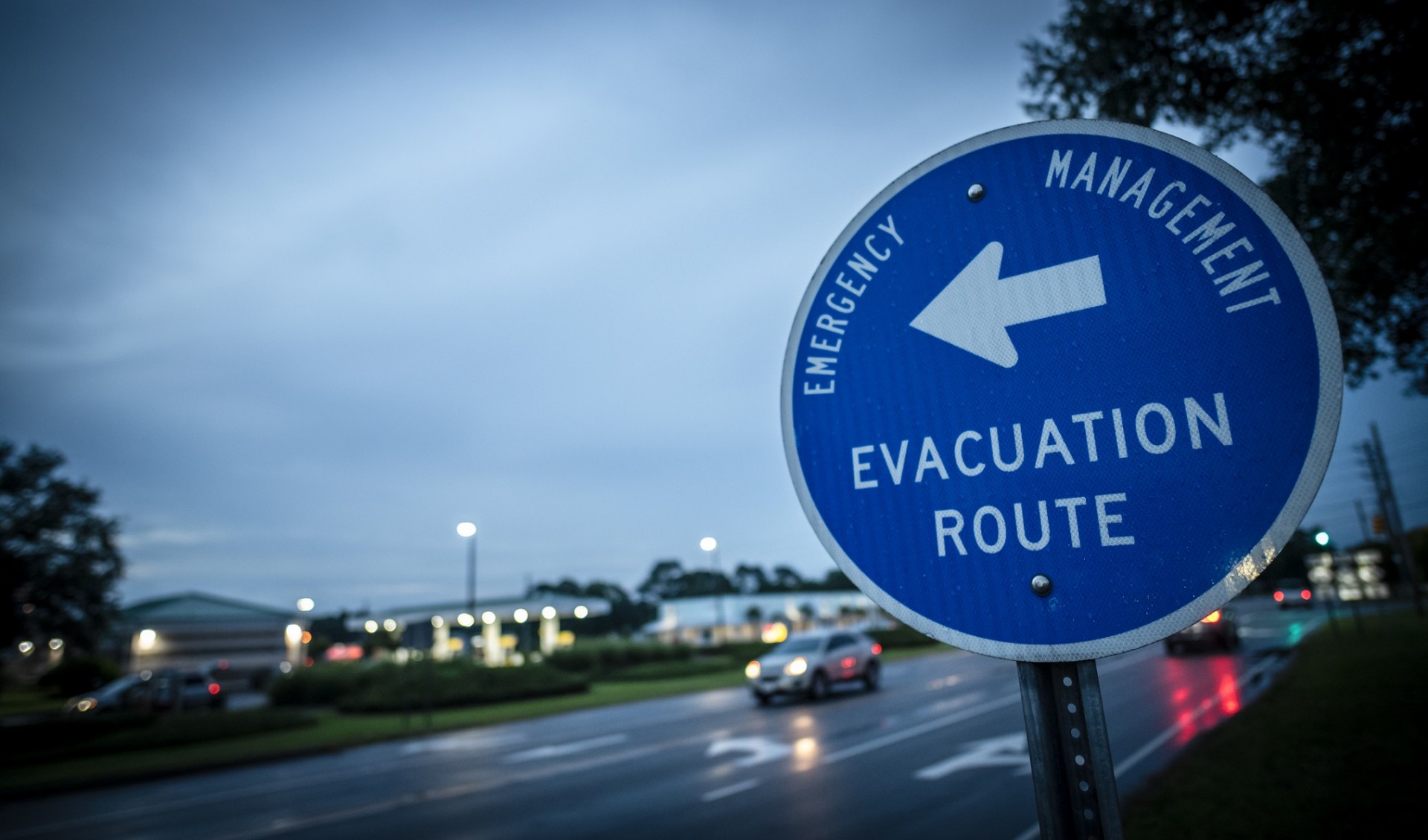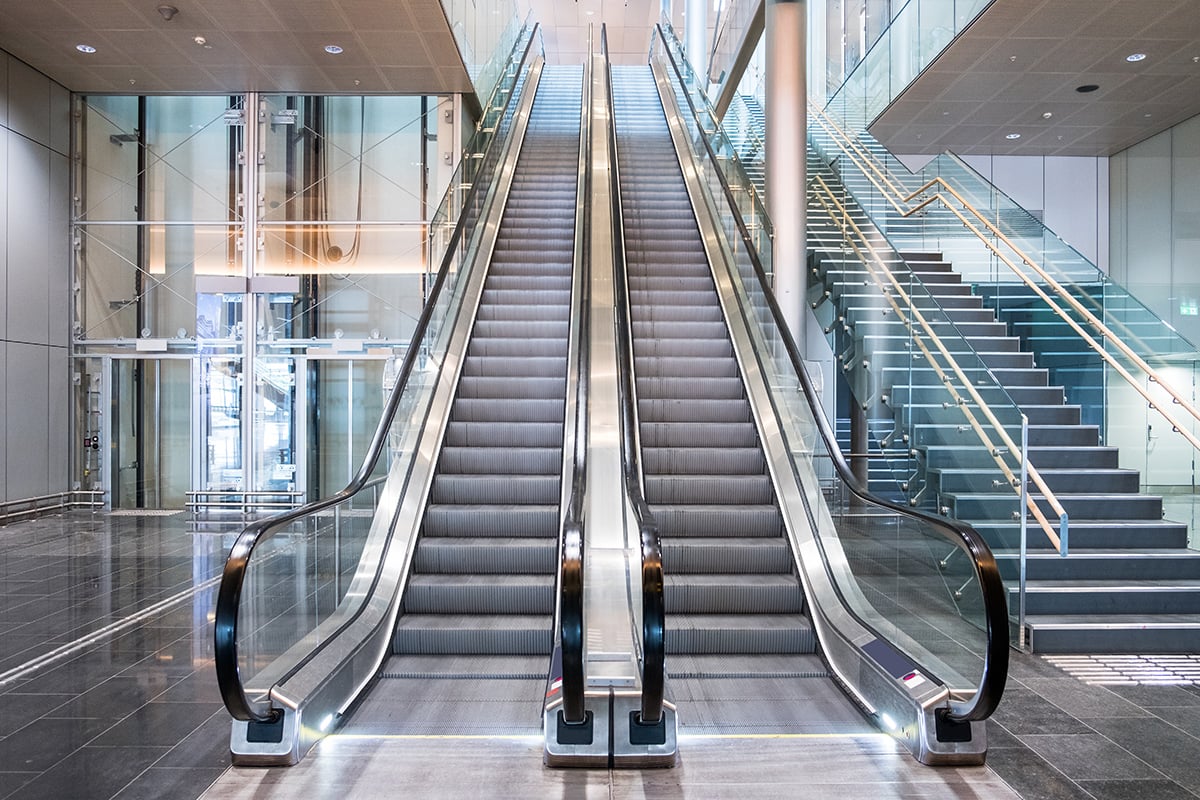Let's try a quick perception experiment. Think of the words "dangerous worksite." Draw a mental picture of what a dangerous worksite might look like. Got an image in mind? Good.
Did you imagine an office with a comfortable chair and desk in a climate controlled building? Most likely this was far from the image you pictured. However, a surprising number of hidden dangers and hazards are present in office settings.
According to data from the Bureau of Labor Statistics, 80,410 private-industry office and administrative workers suffered on-the-job injuries in 2018. Many of these injuries could have been prevented had workers or supervisors recognized the risks and implemented simple workplace modifications to help mitigate them.
So, now that your perception of a dangerous worksite has had a bit of a shake up, let's explore some of the most common hazards found in an office setting and the basic preemptive measures office workers can utilize to prevent injury.
Slips, Trips and Falls
Slips, trips and falls are not only the most common office accident, they are also responsible for causing the most disabling injuries according to the Centers for Disease Control and Prevention (CDC).
In fact, office workers are 2 to 2.5 times more likely to suffer a disabling injury from a fall than non-office workers. Several hazards contribute to these injuries, although most can be significantly reduced, often by raising awareness among employees with safety communication barriers.
Communication barriers can help alert people of hazards, such as slippery floors, icy walkways, or on-site maintenance. Think of these as you first line of defense against many basic fall hazards.
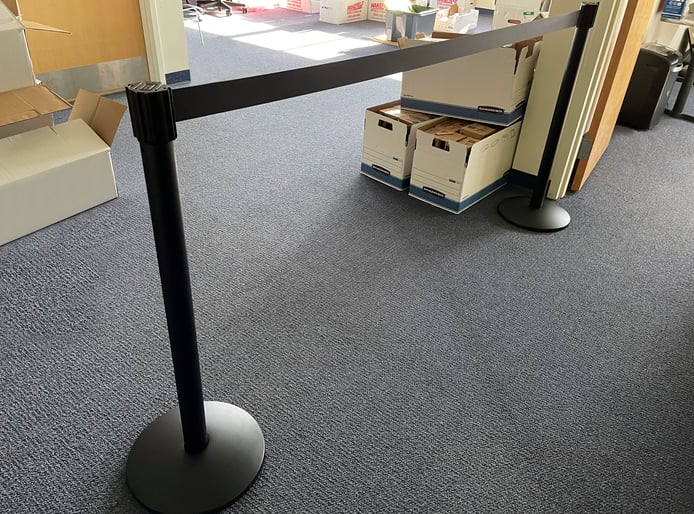 (Pictured Above: Safety barriers provide a physical barrier to help block passerbys from accidentally wandering into trouble.)
(Pictured Above: Safety barriers provide a physical barrier to help block passerbys from accidentally wandering into trouble.)
Other Preventive Tips:
Stay Clutter-Free
Boxes, files and various items piled in walkways can create a tripping hazard, according to OSHA. Be certain that all materials are safely stored in their proper location to prevent buildup of clutter in walkways. Ensure all electrical cords are properly secured and covered. Stretching cords across walkways or under rugs creates a major tripping hazard.
Step On Up
Standing on chairs – particularly rolling office chairs – is a significant fall hazard. Workers who need to reach something at an elevated height should use a stepladder. Workers should never climb higher than the step indicated as the highest safe standing level.
Maintain a Clear Line of Vision
Workers can collide when making turns in the hallways and around blind corners or cubicle walls. The National Safety Council suggests installing convex mirrors at intersections to help reduce collisions. If workers can see who is coming around the corner, collisions are less likely to occur.
Get a Grip
Carpeting and other skid-resistant surfaces can serve to reduce falls. Marble or tile can become very slippery – particularly when wet. Placing carpets down can be especially helpful at entranceways, where workers are likely to be coming in with shoes wet from rain or snow. Consider using a retractable belt barriers to block slippery or icy floors.
Shut the Drawer
File cabinets with too many fully extended drawers could tip over if they are not secured. Additionally, open drawers on desks and file cabinets pose a tripping hazard, so be sure to always completely close drawers when not in use.
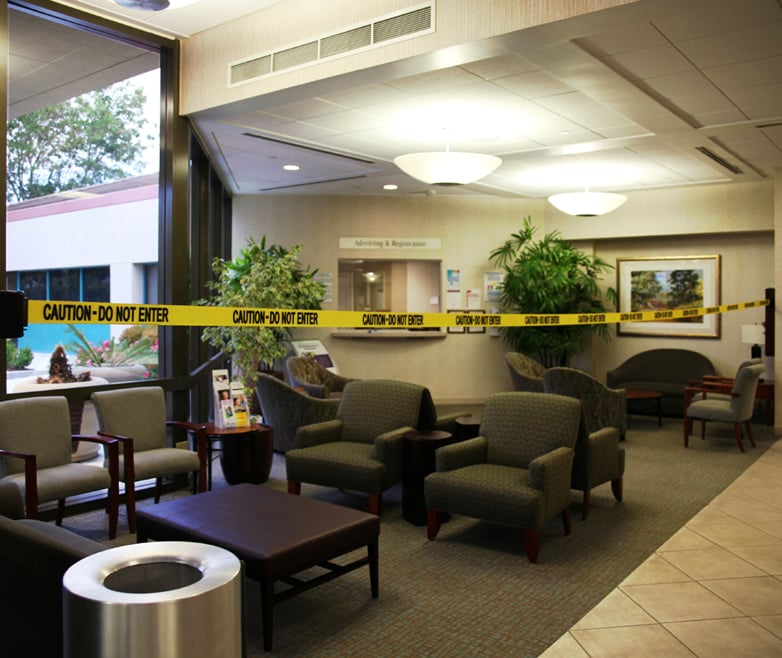 (Pictured Above: Office settings can benefit from using safety barriers to block off hazardous areas.)
(Pictured Above: Office settings can benefit from using safety barriers to block off hazardous areas.)
Dangers of the Desk: Ergonomics Injuries
Sitting at desks for long hours day after day can cause slowly occurring injuries that stem from poor ergonomics. Because of their gradual onset, these hazards are often too subtle to notice... until it’s too late. Poor posture and repeated motions create irritations and inflammations that range from annoying to debilitating. Common injuries include lower back pain and carpal tunnel syndrome.
Provide Adjustable Equipment
One size does not fit all in an office workstation. Chairs, work surfaces, monitor stands, etc., should all be adjustable in order to accommodate the widest range of employees.
According to OSHA's How to Set up an Ergonomically Correct Workstation, you should use these basic guidelines when adjusting your work station:
- Adjust your keyboard or chair height so that, while you're typing, your elbows are at a 90-degree angle and your wrists are straight.
- Adjust your computer monitor so that the top of the screen is at your eye level.
- Use a document holder so your papers can be kept at the same level as your computer monitor.
- Make motions such as typing and stapling with the least amount of force possible.
- Adjust the window blinds or lighting so there is no glare on the computer screen.
Train Workers on How to Use Equipment
Providing adjustable furniture and equipment is only the first step in creating an ergonomically sound workstation. Employee should be properly trained on how to adjust their own office chairs and equipment.
Keep Your Feet on the Floor
Always adjust your office chair so that your thighs are horizontal with the floor, your feet are flat, and the backrest supports your lower back. If your feet do not rest comfortably on the floor, use a footrest. This is best seated position for preventing back strain.
Correct Mouse Placement
It is common for workers to have their computer keyboard on a tray, while their mouse remains on the desk. This incorrect placement spells disaster for the neck and shoulder on the side of the mouse. The mouse should always be placed beside the keyboard to prevent muscle strain.
Know When to Walk Away
Along with setting up your workstation properly, it's essential to take breaks and change your position (whether seated or standing) frequently. For instance, look away from your computer screen for 30 seconds every 10 mintues, and get up to stretch every half hour. This will help to take some of the strain away and reduce your risk of being injured from making repetitive movements (such as typing) without a rest.
Disclaimer: Banner Stakes specializes in retractable belt barriers. For more information on ergonomics, consult a certified ergonomics professional for a comprehensive evaluation of your worksite.
Improper Lifting
Lifting even small loads (stacks of files, computer paper, a computer monitor, etc.) can lead to injury if done improperly. Your back, neck and shoulders are all susceptible to this type of injury. Before you decide to lift anything, be sure it is not too heavy for you (if it is, ask a co-worker or supervisor to help).
Safe Lifting Tips:
Whenever you need to lift something, follow these tips to reduce your risk of injury.
- Lift by squatting toward the floor (when lifting something from the floor) and then using your legs (not your back) to straighten up.
- Allow your back to stay in a straight position.
- Pick up the object with your entire hand (not just your fingers) and hold the load close to your body. Refrain from twisting.
- To set something down, again use your legs for strength, not your back.
Unexpected Hazards: Air Quality, Fire and Electrical Issues
Respiratory disorders such as occupational asthma, allergies, and chemical sensitivities may occur if your office air quality is poor. Cleaning chemicals, dust, overcrowding, blocked airflow, excess dryness, or humidity and inadequate ventilation can create a toxic mix. Poor air quality is another quiet hazard that may need time to cause injury and is difficult to identify.
An Air Quality Plan Should Include:
- Effective maintenance plan for the heating, ventilation, and air conditioning systems, including regular cleaning and filter changes
- Effective housekeeping in the office to control dust, dirt, and pollen
- Regular cleaning and disinfecting of restrooms and break rooms, including appliances such as refrigerators, coffee makers, and microwaves
Fire Hazards
Office fires typically exceed 15,000 occurrences each year, resulting in over $600 million in property damage. Problems often stem from power cables, such as damaged or frayed cables, improper use of extension cords, removing the ground prong from a power cable, space heater use, and overloaded outlets.
One method of preventing electrical accidents is to utilize safety communication barriers as a warning against high voltage equipment, arc flash boundaries, and electrical boxes.
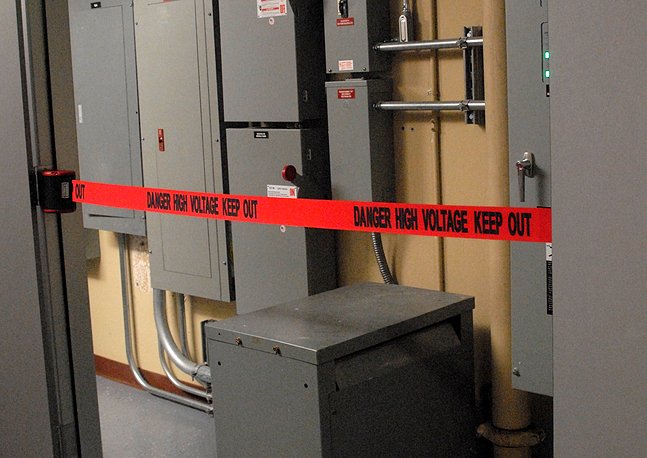
(Pictured Above: Prevent electrical injury by using a barrier as a warning against high voltage equipment, arc flash boundaries, and electrical boxes.)
More Preventative Fire and Electrical Tips:
- Conduct routine inspections for power cord damage and proper use of electrical outlets
- Use extension cords approved by a certifying laboratory in temporary situations only
- Ensure that fire extinguishers are in prominent areas, easily accessible, and are in working order
- Train all employees on how to use fire extinguishers
- Have a solid fire evacuation plan
- Make sure smoke detecters are working properly
Conclusion
The safety of your office starts with taking the right steps to prevent accidents from happening. Safety barriers can be a useful tool you can use to help this process. Setting up safety boundaries in hazardous areas is your first line of defense against many basic office accidents - providing a powerful visual cue and physical barrier to alert workers and visitors to be mindful of their surroundings. The pay-off is enormous if it prevents even one life-threatening injury from occurring.
Secure Your Office's Safety with Banner Stakes
Banner Stakes offers barrier systems that are durable, versatile, convenient and with greater visibility than anything else on the market.
The multi-surface wall mount Magnetic Line system features rare earth magnets, the strongest in existence, to produce significantly stronger and more durable attachment. These versatile and retractable barriers use integrated suction cups to allow you to attach to more surfaces including metal, stainless steel, glass, wood and plastic.
Banner Stakes PLUS Line features industrial strength barriers made to withstand harsh working environments for both indoor and outdoor use. These barriers will not corrode or rust over time. The base can be filled with water or sand so they will not tip over. The PLUS Line cart provides convenient storage, easy mobility, and quick assembly.
All of Banner Stakes retractable banners are 2.5” wide, which is 25% larger than the standard competitor belt to increase visibility and safety.
Interesting in learning more? We can assist you in finding safety products to create a safer workplace and meet compliance requirements.
Contact us today so we can start discussing your office's safety program.
Need help improving your worksite's overall safety program? We're here to help!
Schedule a site walk with us, and we'll build a safety plan tailored to your facility's exact operations and layout.

